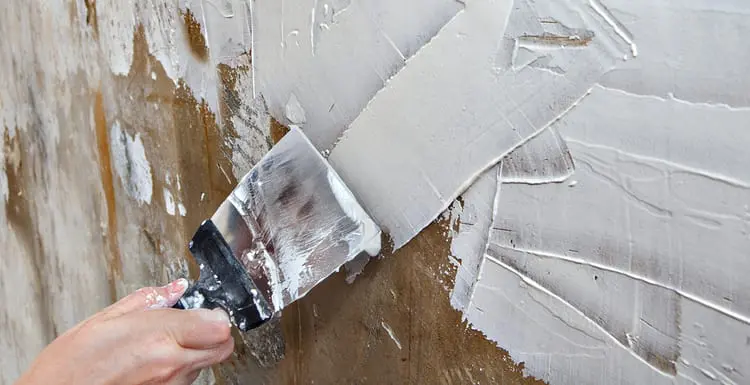Stucco homes undeniably stand out. When you think of a house with stucco siding, many of us picture an Italian or Spanish villa. We know that stucco looks great, but what is the material made of?
How strong is it? What’s the upkeep like? If you’re considering stucco siding or looking at a stucco home, you want to learn as much as you can about this unique material.
Stucco’s interesting, rich history, appealing appearance, and durable qualities make it one of the most popular siding materials. But it’s not for everyone or every area. Read on to learn about stucco and decide if it’s right for your home.
What Is Stucco?
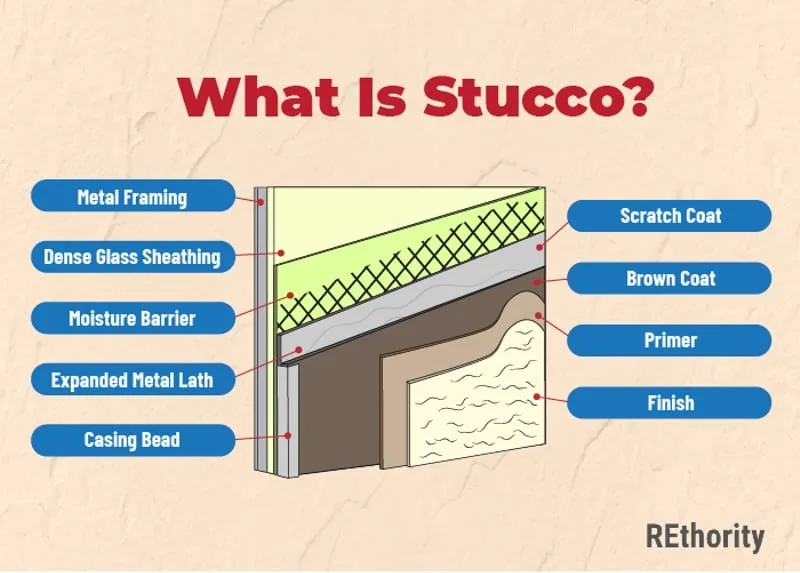
Stucco is a plaster-like material made of cement, sand, lime, and water. In fact, stucco means “plaster” in Italian. It’s been around for centuries and is used in both construction and art.
You’ll see stucco used as siding in a range of colors and textures. Today, it is especially popular in California, Florida, and the southwestern United States. The appearance is similar to adobe.
Stucco is applied in two or three coats to give it its characteristic texture and finish. A fine sand appearance, a rough and pitted surface, and artistic grooves and designs are all possible stucco textures.
It can also be applied smoothly. The possibilities are endless because the material can be mixed with different textured materials and molded however the homeowner wants.
Unlike other siding options, like brick, stone, wood, or vinyl, stucco has a seamless, solid shell appearance. It completely covers the exterior (or portions of the exterior) of a home.
For this reason, stucco can offer a home an additional layer of protection from the elements. However, certain climates and weather patterns can weaken and damage stucco.
This is why it’s important to do plenty of research before deciding to use stucco or buy a stucco home.
What Is Stucco Made Of?
Stucco is always an aggregate mixture of some type of cement, sand, and water. Colors can be added, and different materials (such as stone or brick) can be embedded in stucco as it dries.
As mentioned above, ancient Greeks and Romans once used gypsum (a calcium-based material used in drywall and chalk) and marble dust to make early stucco, but this wasn’t very durable and strong.
It was more suitable as a binder to hold stones together. Italians improved on that practice by using lime-based stucco (Venetian plaster) that did a better job of holding up to the humid environment in Venice, a city built entirely on water.
The History of Stucco
Stucco has been used throughout history for more than five thousand years. While we mainly associate it with the Spanish Mission style of architecture today, it has been used all over the world in nearly every culture.
South and Central America, ancient Greece and Rome, the Middle East, and Italy have been home to stucco buildings and sculptures for centuries.
It became especially popular and one of Europe’s most commonly used materials during the Age of Renaissance. Back then, stucco was mixed and utilized differently according to the available materials and architectural styles in the area.
The ancient Greeks and Romans used marble dust, gypsum, and glue to make stucco. Italians used a stronger, lime-based stucco closer to the mixture used today (though we now use Portland cement, a mixture of limestone and clay or shale).
Around the 1800s, stucco made its way to the United States. But it wasn’t until the 20th century that the material became popular here, used most commonly in dry, hot climates.
Stucco Pros and Benefits
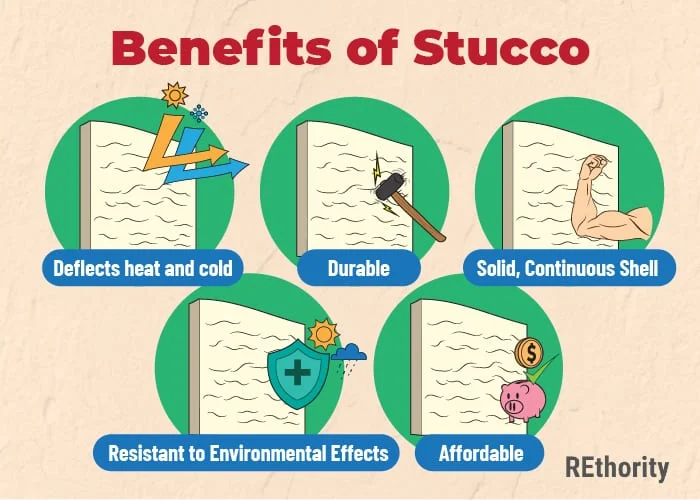
This material used throughout history has a lot of benefits and advantages even today. Here are the pros associated with using stucco.
Solid, Continuous Shell
Once stucco is properly applied and cured, it creates a complete shell around a structure. This shell is quite protective, so long as it doesn’t crack or break.
By creating a solid shell around a building, stucco can make the structure stronger. It can also help hide unsightly materials by covering them completely.
Deflects Heat and Cold
Stucco is an energy-efficient material because of the complete, solid shell it forms. It is resistant to glare, so in very sunny and hot areas, it actually deflects heat.
While it is not as effective at trapping heat inside the home, it is very good at stopping outside temperature changes from significantly affecting the interior of the home.
Durable
Stucco is quite strong and durable compared to plaster. A hammer blow can still damage it, but simple scrapes, scratches, and bumps won’t. The durability makes it an excellent choice for both interior and exterior usage.
Stucco’s durability has been continually improved over the years. Today’s stucco is much more durable than the material used in ancient Greece and Rome and can last 60 to 100 years without needing repairs.
Resistant to Damaging Environmental Effects
Stucco is appealing as a building material because it is so resistant to different environmental effects. Stucco is water-resistant, heat and cold resistant, and fire-resistant.
It can even be applied over materials that do not have these qualities to improve the safety and durability (such as wood). A one-inch layer of stucco adds a one-hour fire rating to a wall!
Affordable
Stucco is much more affordable than some other popular types of siding. The average cost of stucco siding for 1,000 square feet is $2,810 to $4,400.
Compare that to the cost of brick for the same square footage at $9,880 to $13,250, or the cost of natural stone at up to $70,000 for an average-sized house.
Combined with stucco’s durability, the lower cost and damage resistance make it one of the most cost-effective siding choices available.
Stucco Cons and Disadvantages
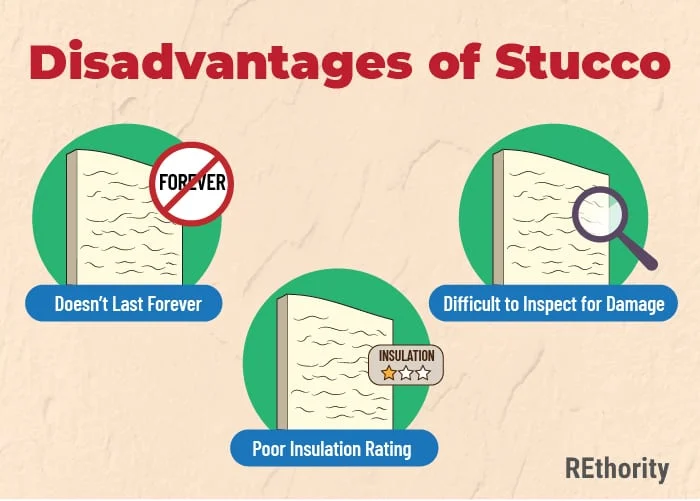
While stucco has a lot of benefits, it isn’t without its disadvantages. Here are a few reasons stucco isn’t always the perfect building material.
Doesn’t Last Forever
It can last up to 100 years without needing repairs, but stucco doesn’t last forever (without at least needing a touch-up). Once moisture gets under it, or it is cracked, repairs have to be made quickly to prevent the issue from getting worse.
Damage that goes too far requires the stucco to be completely removed and reapplied. And that’s a pain. I’d know — I had to replace a lot of stucco at one of my rental homes.
Difficult to Inspect for Damage
Stucco isn’t made up of multiple pieces like siding, brick, or stone. The only way to see if damage is occurring under stucco is to create a hole – which will need to be immediately repaired afterward.
Stucco can look like it’s in great condition while it’s hiding potential rot and warping issues underneath.
Poor Insulation Rating
Stucco does a good job of deflecting heat and cold, but it’s not a great insulator. It is most often used in dry, hot climates because it can resist glare and won’t hold heat.
However, this material doesn’t do a good job of insulating and holding heat inside the structure it covers. That makes it an uncommon choice for areas where it gets cold during even part of the year.
How to Clean Stucco
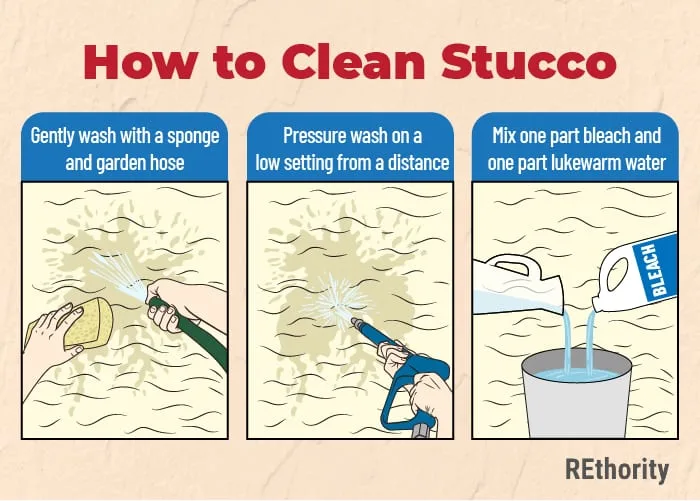
If you find yourself in a stucco home or plan to have stucco siding installed, you’ll need to know how to maintain it by keeping it clean.
Cleaning stucco is a bit different from cleaning other types of siding, but it’s simple to do. Just make sure to clean it regularly!
There are three methods you can use to clean stucco.
- Gentle clean. Use a garden hose or bucket of water and soap to spot clean stucco. Ensure the sponge or brush you use is soft, and don’t be overly aggressive in your cleaning. This will help you avoid damaging the stucco.
- Pressure wash. Pressure washing stucco that is very dirty can be effective. The enhanced power helps remove dirt and grime that a hose and light scrubbing would not. Be careful to apply pressure from the correct distance to avoid chipping or damaging the stucco.
- Remove mold and mildew. If mold and mildew have begun to grow on stucco, you can use a bleach solution to remove it. Mix one part bleach and one part lukewarm water, then use a sponge or brush to spot test an inconspicuous area. Let it sit for 5 minutes before rinsing and look for any color changes. If none, apply it wherever you see mold or mildew. Let it sit for about 5 minutes, then thoroughly rinse it off.
How to Know If Stucco Is Right for You
Whether you’re thinking about having stucco siding installed or are looking at a stucco home, it’s important to think about the pros and cons of stucco to see if it’s right for you.
Here are the main things you’ll want to consider:
- Your location. The climate, average rainfall, proximity to water, and more can all affect the durability and effectiveness of stucco. If you’re in a dry, hot area, stucco can be a great choice because it deflects heat and keeps the interior nice and cool. If you’re in a humid area, or where it gets very cold, stucco is a poor choice because it’s not a great insulator and is prone to damage from humidity.
- The look. Stucco is a look in and of itself, so how does it fit with the way you want your home to appear? Stucco looks most natural on Spanish Mission-style architecture, but it’s an interesting twist to add to other architectural styles as well. Make sure you like the unique appearance of stucco enough to choose it for your home.
- Repairs and damage. Stucco is more easily damaged than other types of siding like brick and natural stone. Are you willing to be vigilant about maintaining stucco and having any small cracks or holes fixed right away? That’s the only way to keep it in good condition long term.
- Cost. Stucco is more costly than non-insulated vinyl siding, but consider how affordable stucco is compared to other siding types like stone or brick. If you’d love a natural stone home but can’t afford the high price, stucco could be a great option. You can have a builder use stucco techniques like roughcast or pebbledash to get the stone look without the higher cost.
Overall, stucco is best for dryer, warmer climates. It’s something you’re better off avoiding in humid, cooler climates because water is its mortal enemy.
However, the upfront expense is lower, it’s an attractive, natural siding choice, and it lasts for up to a century without needing repairs in the right setting.
If you like the look and are willing to keep up with regular cleaning and maintenance, stucco could be the right choice for you.

